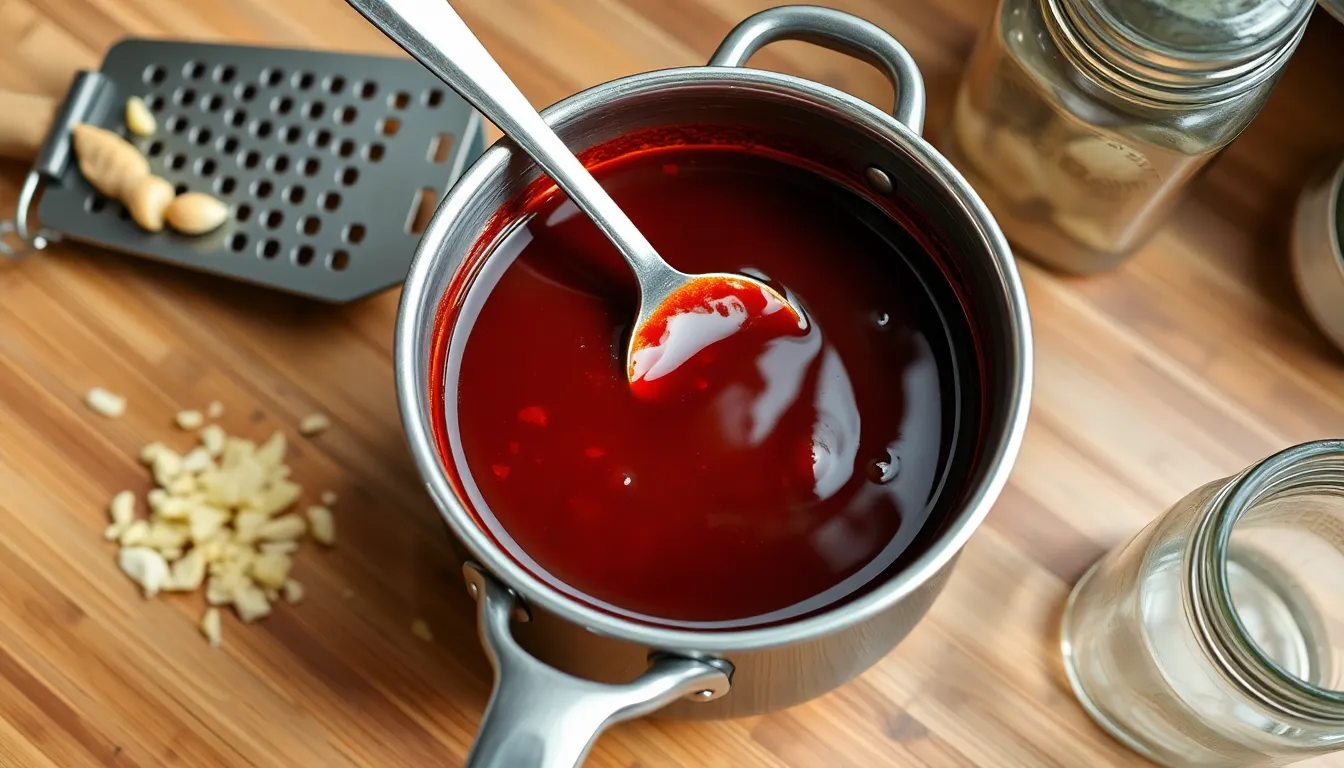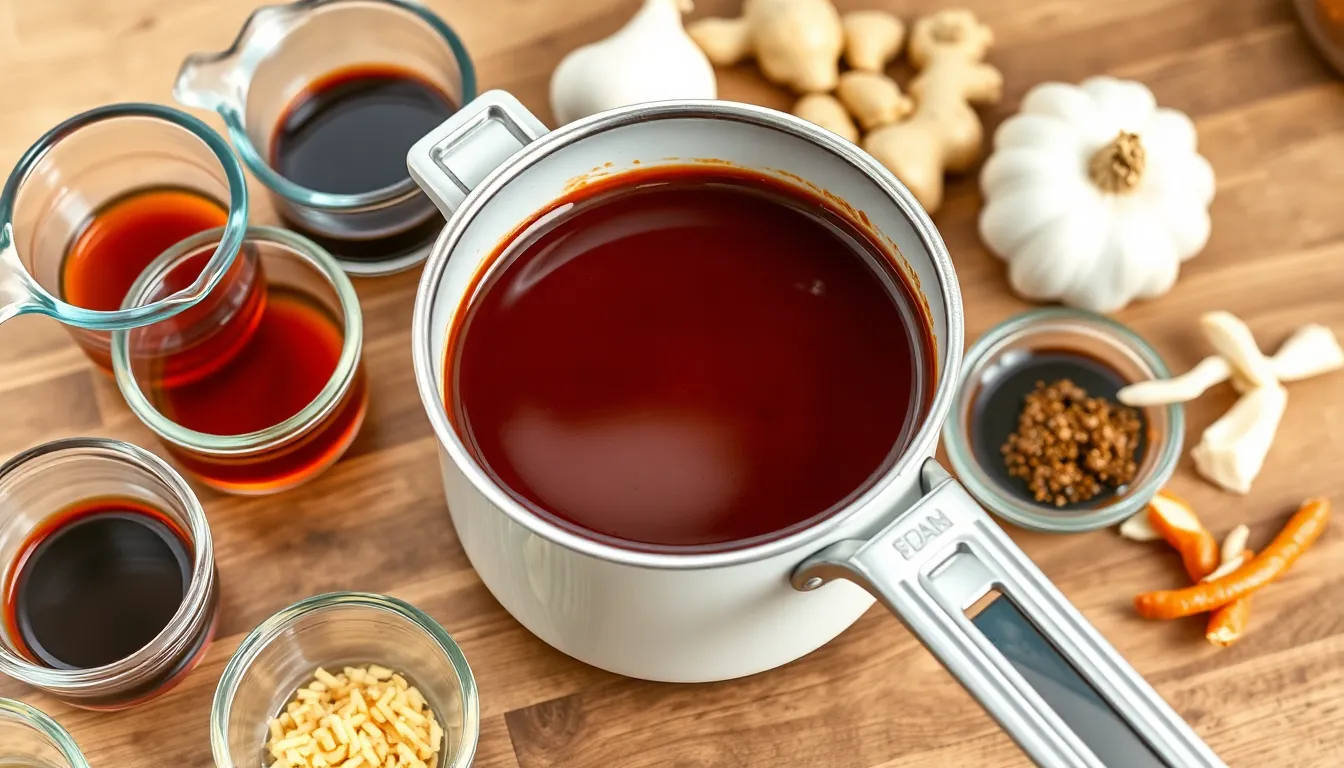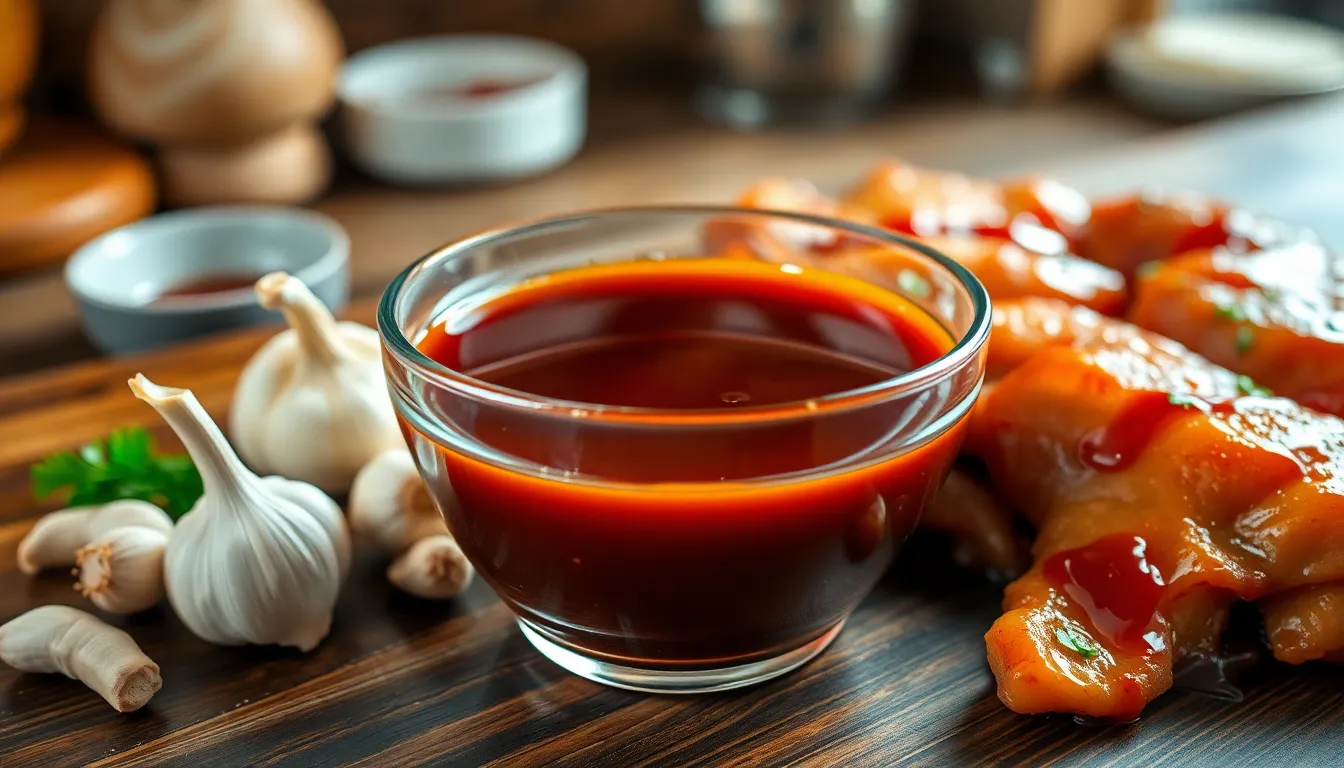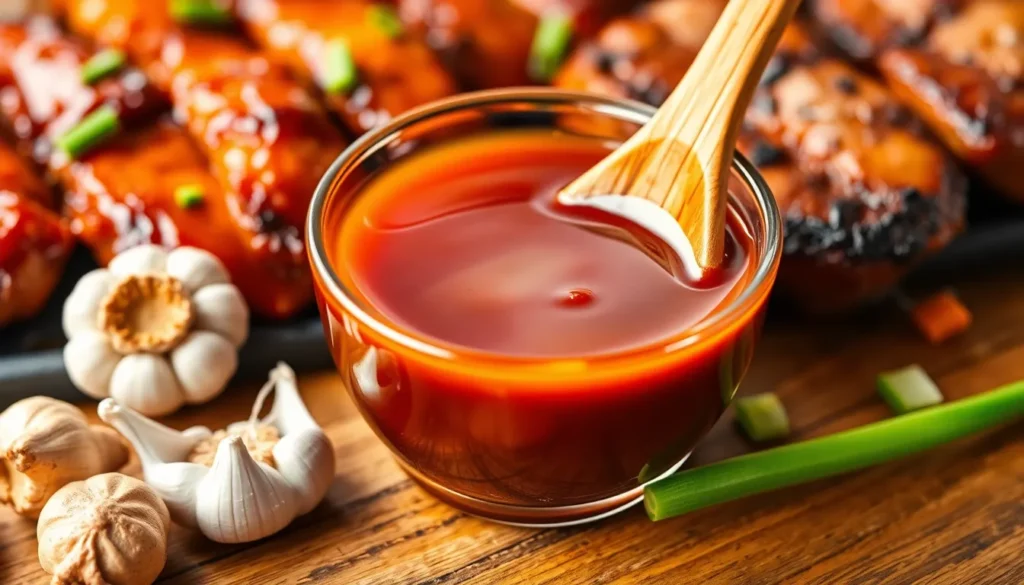Chinese BBQ sauce transforms ordinary grilled meats into restaurant-quality masterpieces that’ll have your family begging for seconds. This sweet and savory glaze delivers that perfect balance of hoisin richness, soy sauce depth, and aromatic five-spice warmth that makes authentic Chinese barbecue so irresistible.
We’ve perfected this recipe to capture those complex flavors you’d find at your favorite dim sum restaurant. The sauce works beautifully on pork ribs, chicken wings, or even roasted vegetables – creating that glossy caramelized coating that’s pure perfection.
What makes our version special? We use simple pantry ingredients that pack maximum flavor punch without any complicated techniques. In just 15 minutes, you’ll have a sauce that rivals anything you’d buy in stores, plus you control the sweetness and spice levels to match your taste preferences perfectly.
Ingredients
We’ve crafted this Chinese BBQ sauce recipe using ingredients you likely have in your pantry right now. Our ingredient list focuses on authentic flavors while keeping preparation simple and accessible.
For the Base Sauce
- 1/2 cup hoisin sauce
- 1/4 cup low-sodium soy sauce
- 3 tablespoons honey
- 2 tablespoons rice wine vinegar
- 1 tablespoon brown sugar
- 1 tablespoon tomato paste
- 1 teaspoon sesame oil
For the Aromatics
- 3 cloves garlic, minced
- 1 tablespoon fresh ginger, grated
- 2 green onions, white parts only, finely chopped
- 1 teaspoon Chinese five-spice powder
- 1/2 teaspoon ground white pepper
Optional Add-ins
- 1-2 teaspoons chili garlic sauce (for heat)
- 1 tablespoon Shaoxing cooking wine (for depth)
- 1 teaspoon cornstarch mixed with 2 teaspoons water (for thickening)
- 1 tablespoon black bean sauce (for umami boost)
- 1/2 teaspoon smoked paprika (for subtle smokiness)
Equipment Needed

Creating this authentic Chinese BBQ sauce requires minimal kitchen equipment that most home cooks already have on hand. We need just a few essential tools to transform our ingredients into that glossy restaurant-quality sauce.
A small saucepan serves as our primary cooking vessel for combining and heating the sauce ingredients. The compact size allows us to control the temperature more precisely while preventing the sauce from burning during the thickening process.
Our stirring spoon or whisk becomes crucial for dissolving the brown sugar completely and ensuring all ingredients blend seamlessly. Constant stirring prevents the molasses and sugar from sticking to the bottom of the pan while maintaining that smooth consistency we want.
A grater handles the fresh garlic and ginger preparation efficiently. Fresh aromatics provide significantly more flavor than their dried counterparts and the grater creates the perfect texture for even distribution throughout our sauce.
For storage, we need a heat-proof container or jar that can withstand the warm sauce temperature. Glass jars work exceptionally well as they allow us to see the sauce’s beautiful color while keeping it fresh in the refrigerator for up to 4 days.
| Equipment | Purpose | Alternative |
|---|---|---|
| Small saucepan | Primary cooking vessel | Medium saucepan (requires more attention) |
| Stirring spoon/whisk | Blending ingredients | Wooden spoon |
| Grater | Fresh garlic and ginger prep | Microplane or fine grater |
| Heat-proof container | Storage | Mason jar or glass container |
These basic tools ensure we can create our Chinese BBQ sauce from start to finish without any specialized equipment. The simplicity of our equipment list matches the straightforward nature of this recipe while delivering professional results.
Instructions

These step-by-step instructions will guide you through creating our authentic Chinese BBQ sauce that transforms ordinary ingredients into restaurant-quality flavor. The process takes just 15 minutes from start to finish.
Prep the Ingredients
We begin by measuring and preparing all components before cooking starts. Combine 1/4 to 1/2 cup hoisin sauce, 1/3 to 4 tablespoons brown sugar, 2 to 4 tablespoons soy sauce, and 1/4 cup oyster sauce (if using) in your workspace. Measure 2 to 4 tablespoons Shaoxing wine or sherry and set aside. Mince 3 to 6 cloves garlic finely and grate 1 to 3 inches fresh ginger using your grater. Have 1 teaspoon five spice powder and 2 tablespoons molasses ready if you’re including these optional ingredients.
Make the Sauce Base
Pour the hoisin sauce, brown sugar, soy sauce, and oyster sauce into your small saucepan or mixing bowl. Whisk these ingredients together until the mixture appears smooth and uniform. The brown sugar should begin dissolving immediately as you stir. This foundation creates the sweet and savory balance that defines authentic Chinese BBQ sauce.
Add Aromatics and Seasonings
Stir the minced garlic and grated ginger directly into our sauce base. Add the Shaoxing wine or sherry now, followed by five spice powder and molasses if you’re using them. Mix thoroughly with your whisk to ensure even distribution of all aromatics. The mixture will become fragrant as the garlic and ginger release their oils.
Simmer and Thicken
Place your saucepan over medium heat and bring the mixture to a gentle simmer. Stir constantly with your spoon or whisk to prevent sticking and ensure even cooking. The sauce will begin bubbling lightly after 2-3 minutes. Continue simmering for approximately 10 minutes total, stirring continuously until the sugar completely dissolves and the sauce thickens enough to coat the back of your spoon. The consistency should be glossy and slightly syrupy.
Strain and Cool
Remove the saucepan from heat and let the sauce cool for 2-3 minutes. Strain the mixture through a fine mesh strainer to remove garlic and ginger solids if you prefer a smooth texture. Allow the sauce to reach room temperature before transferring to your heat-proof storage container. Store in an airtight container in the refrigerator for up to 4 days or freeze for up to 3 months for future use as a marinade, glaze, or dipping sauce.
Storage Instructions

We recommend proper storage techniques to maximize the shelf life and maintain the quality of your homemade Chinese BBQ sauce. Allow the sauce to cool completely to room temperature before transferring it to storage containers.
Refrigerator Storage
Our sauce stays fresh in the refrigerator for up to 1 week when stored correctly. Transfer the cooled sauce to an airtight container or glass jar with a tight-fitting lid. The sauce will naturally thicken as it cools, creating the perfect consistency for glazing meats or using as a dipping sauce.
Freezer Storage
For extended storage, we suggest freezing the sauce in freezer-safe airtight containers. Properly stored frozen Chinese BBQ sauce maintains its quality for up to 3 months. When ready to use, thaw the sauce completely in the refrigerator before applying to your dishes.
| Storage Method | Duration | Container Type |
|---|---|---|
| Refrigerator | Up to 1 week | Airtight container or jar |
| Freezer | Up to 3 months | Freezer-safe airtight container |
Storage Tips
We find that glass jars work exceptionally well for refrigerator storage as they prevent flavor absorption and make it easy to see the sauce level. Label containers with the preparation date to track freshness. The sauce consistency becomes more viscous when chilled, making it ideal for coating proteins during cooking. Always use clean utensils when removing sauce from storage containers to prevent contamination and extend shelf life.
Ways to Use Chinese BBQ Sauce

Now that we’ve mastered our homemade Chinese BBQ sauce recipe, let’s explore the versatile ways this flavorful condiment transforms ordinary meals into extraordinary dishes. This sweet and savory sauce brings authentic dim sum restaurant flavors to our home cooking adventures.
For Marinades
We love using our Chinese BBQ sauce as a powerful marinade that tenderizes meat while infusing deep flavors. The sauce works perfectly with pork, chicken, or smaller meat pieces destined for stir-fries. Marinating proteins for at least 30 minutes allows the hoisin and soy sauce base to penetrate the meat fibers, creating incredibly tender and flavorful results.
Pork shoulder and chicken thighs respond exceptionally well to overnight marinating in our sauce. The brown sugar and honey components help caramelize the exterior during cooking while the garlic and ginger aromatics develop complex flavor layers. We recommend scoring thicker cuts of meat before marinating to maximize flavor absorption.
As a Glaze
Our Chinese BBQ sauce excels as a finishing glaze thanks to its naturally thick consistency that clings beautifully to cooked proteins. We brush the sauce onto pork ribs, chicken wings, or roasted vegetables during the final 10-15 minutes of cooking time. This technique creates that signature glossy, caramelized coating reminiscent of authentic char siu.
The key to perfect glazing lies in timing. We apply multiple thin layers rather than one thick coating, allowing each application to set before adding the next. This method prevents burning while building up that coveted lacquered appearance that makes Chinese BBQ so visually appealing.
For Stir-Fries
Adding our Chinese BBQ sauce to stir-fries creates restaurant-quality dishes with minimal effort. We typically add 2-3 tablespoons of sauce during the final minute of stir-frying, tossing quickly to coat all ingredients evenly. The sauce adds that essential sweet-salty dimension that complements both vegetables and proteins.
Beef and broccoli transforms into something special when finished with our sauce, while simple vegetable stir-fries gain incredible depth. The sesame oil and five-spice powder components shine particularly well in wok cooking, where high heat intensifies their aromatic qualities.
As a Dipping Sauce
We find our Chinese BBQ sauce makes an exceptional dipping sauce for everything from spring rolls to grilled meats. Cooking the sauce beforehand enhances both taste and texture, creating the ideal consistency for dipping. The umami-rich profile pairs wonderfully with fried appetizers and roasted proteins.
For optimal dipping consistency, we sometimes thin the sauce slightly with rice wine vinegar or add a touch of sesame oil for extra richness. This versatile condiment even works as an innovative replacement for traditional Western BBQ sauces, bringing Asian flavors to familiar dishes like grilled chicken or pork tenderloin.
Recipe Variations

Our Chinese BBQ sauce recipe serves as the perfect foundation for creating customized versions that suit different taste preferences and dietary needs. We can easily adapt the base recipe by adjusting exact ingredients or adding complementary flavors.
Spicy Chinese BBQ Sauce
We transform our classic recipe into a fiery version by incorporating chili garlic sauce or fresh chopped chili peppers. Start with 1-2 tablespoons of chili garlic sauce mixed into the base recipe and adjust according to your heat tolerance. Fresh jalapeño or serrano peppers work wonderfully when minced finely and added during the simmering process. The key lies in maintaining the delicate balance between heat and the sauce’s natural sweetness and savory depth. We recommend tasting as you go to ensure the spice level complements rather than overwhelms the other flavors.
Sweet and Tangy Version
Our sweet and tangy variation elevates the sauce’s bright notes by increasing the brown sugar or honey content slightly. Add an extra tablespoon of brown sugar to the base recipe along with 1-2 tablespoons of rice vinegar or fresh lemon juice. This combination creates a more pronounced sweet-sour profile that pairs beautifully with grilled meats and roasted vegetables. The additional acidity from the vinegar cuts through rich proteins while the extra sweetness provides a lovely caramelized finish when used as a glaze. We find this version particularly effective for chicken wings and pork ribs.
Low-Sodium Option
We create a heart-healthy version by substituting low-sodium soy sauce for regular soy sauce and reducing or completely omitting the oyster sauce. This modification significantly decreases the salt content without sacrificing the complex umami flavors that make our sauce so appealing. Replace the oyster sauce with an additional tablespoon of hoisin sauce to maintain the sauce’s body and depth. The result delivers all the authentic Chinese BBQ flavors while accommodating sodium-restricted diets. We ensure the garlic and ginger quantities remain generous to compensate for any flavor reduction from the lower sodium content.
Tips for Best Results

We recommend simmering the sauce for optimal flavor development. Cooking the raw aromatics like garlic and ginger transforms their sharp edges into mellow sweetness while intensifying the overall taste profile. This process also makes the sauce safer for use as a dipping sauce since all ingredients become fully cooked.
Temperature control makes a important difference in achieving the perfect consistency. We keep the heat at medium-low to prevent scorching while allowing the sauce to reduce properly. Stirring continuously during the simmering process prevents sticking and ensures even cooking throughout.
Taste testing during preparation allows us to balance the flavors precisely. After initial mixing but before the final simmer we adjust sweetness with additional brown sugar or saltiness with more soy sauce. This customization ensures the sauce matches our preferred flavor profile perfectly.
Achieving the traditional bright red color requires exact ingredients. We add red fermented bean curd for authentic color and subtle flavor enhancement. Alternatively food coloring creates the visual appeal without affecting taste if fermented bean curd is unavailable.
Proper thickening technique creates the ideal coating consistency. We simmer until the sauce coats the back of a spoon which typically takes about 10 minutes. This thickness allows the sauce to cling beautifully to meats during cooking while creating that signature glossy finish.
Fresh aromatics deliver superior results compared to dried alternatives. We grate ginger and garlic just before use to capture maximum flavor and aroma. Pre-minced versions from jars lack the intensity that fresh ingredients provide.
Reapplication during cooking builds layers of flavor and enhances the final appearance. We brush additional sauce onto meats multiple times throughout the cooking process. Each layer caramelizes and creates depth while contributing to the characteristic lacquered finish of authentic Chinese BBQ.
Conclusion
We’ve created more than just a sauce recipe – we’ve unlocked the secret to bringing authentic Chinese restaurant flavors into our home kitchens. This versatile Chinese BBQ sauce transforms ordinary ingredients into something extraordinary with its perfect balance of sweet savory and aromatic elements.
The beauty of this recipe lies in its simplicity and adaptability. Whether we’re grilling marinating or stir-frying we now have a go-to sauce that delivers consistent professional results every time. With proper storage techniques and customization options we can always have this flavor enhancer ready to elevate our meals.
Start experimenting with this recipe today and discover how this one sauce can revolutionize our approach to Asian-inspired cooking. The restaurant-quality results we’ll achieve will make this Chinese BBQ sauce a permanent fixture in our culinary repertoire.
Frequently Asked Questions
What is Chinese BBQ sauce made of?
Chinese BBQ sauce combines hoisin sauce, soy sauce, honey, rice wine vinegar, brown sugar, tomato paste, and sesame oil as its base. Aromatics like garlic, ginger, green onions, Chinese five-spice powder, and white pepper enhance the flavor. Optional ingredients include chili garlic sauce, Shaoxing wine, cornstarch, black bean sauce, and smoked paprika for added complexity.
How long does homemade Chinese BBQ sauce last?
Homemade Chinese BBQ sauce stays fresh in the refrigerator for up to one week when stored in an airtight container or glass jar. For longer storage, it can be frozen in freezer-safe containers for up to three months. Always use clean utensils when removing sauce to prevent contamination and extend shelf life.
Can I make Chinese BBQ sauce spicy?
Yes, you can easily make Chinese BBQ sauce spicy by adding chili garlic sauce, fresh minced peppers, or red pepper flakes during preparation. Start with small amounts and taste-test to achieve your desired heat level. The spicy version maintains the sauce’s sweet-savory balance while adding a kick of heat.
How do I use Chinese BBQ sauce for cooking?
Chinese BBQ sauce is versatile and can be used as a marinade for meats, a finishing glaze for grilled proteins, or added to stir-fries. It works excellently as a dipping sauce for appetizers and can replace traditional Western BBQ sauces. Apply it during the last few minutes of cooking to prevent burning.
What equipment do I need to make Chinese BBQ sauce?
You only need basic kitchen equipment: a small saucepan for cooking, a stirring spoon or whisk for blending, a grater for fresh garlic and ginger, and a heat-proof container for storage. No specialized equipment is required, making this recipe accessible for any home cook with standard kitchen tools.
How thick should Chinese BBQ sauce be?
Chinese BBQ sauce should have a glossy, pourable consistency that coats the back of a spoon. If it’s too thin, simmer longer to reduce and thicken, or add a cornstarch slurry. If too thick, thin with a small amount of water or rice wine vinegar until you reach the desired consistency.
Can I make a low-sodium version of Chinese BBQ sauce?
Yes, create a low-sodium version by using low-sodium soy sauce and omitting oyster sauce. Reduce the amount of hoisin sauce slightly and add extra aromatics like garlic and ginger to maintain flavor depth. You can also substitute some soy sauce with rice wine vinegar for tanginess without added sodium.
How do I get the traditional red color in Chinese BBQ sauce?
The traditional bright red color comes from red fermented bean curd (nam yue) or Chinese red food coloring. Add small amounts gradually until you achieve the desired hue. Some recipes use tomato paste or ketchup for color, though this slightly alters the authentic flavor profile.







